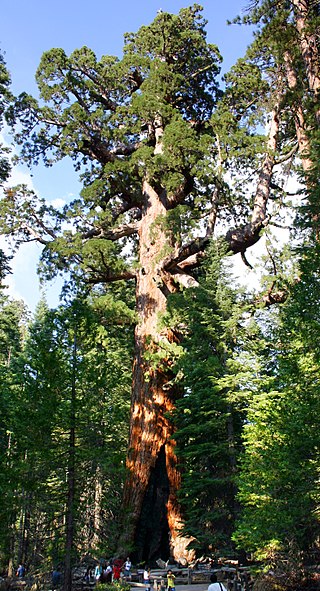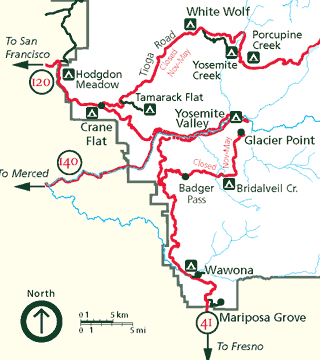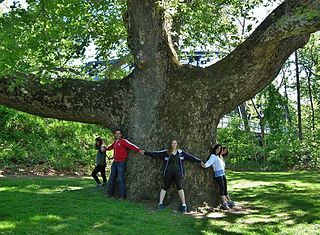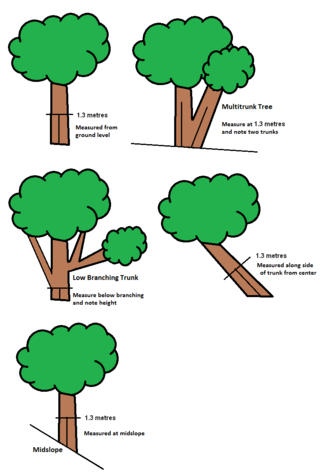
Sequoiadendron giganteum, also known as the giant sequoia, giant redwood or Sierra redwood is a coniferous tree, classified in the family Cupressaceae in the subfamily Sequoioideae. Giant sequoia specimens are the most massive trees on Earth. They occur naturally only in groves on the western slopes of the Sierra Nevada mountain range of California.

Ulmus americana, generally known as the American elm or, less commonly, as the white elm or water elm, is a species of elm native to eastern North America, naturally occurring from Nova Scotia west to Alberta and Montana, and south to Florida and central Texas. The American elm is an extremely hardy tree that can withstand winter temperatures as low as −42 °C. Trees in areas unaffected by Dutch elm disease (DED) can live for several hundred years. A prime example of the species was the Sauble Elm, which grew beside the banks of the Sauble River in Ontario, Canada, to a height of 43 m (140 ft), with a d.b.h of 196 cm (6.43 ft) before succumbing to DED; when it was felled in 1968, a tree-ring count established that it had germinated in 1701.

Coffee County is a county located in the southeastern part of the U.S. state of Georgia. As of the 2020 census, the population was 43,092, up from 42,356 at the 2010 census. The county seat is Douglas.

Mariposa Grove is a sequoia grove located near Wawona, California, United States, in the southernmost part of Yosemite National Park. It is the largest grove of giant sequoias in the park, with several hundred mature examples of the tree. Two of its trees are among the 30 largest giant sequoias in the world. The grove closed on July 6, 2015, for a restoration project and reopened on June 15, 2018.

The Wye Oak was the largest white oak tree in the United States and the State Tree of Maryland from 1941 until its demise in 2002. Wye Oak State Park preserves the site where the revered tree stood for more than 400 years in the town of Wye Mills, Talbot County, Maryland.

The Shawnee National Forest is a United States National Forest located in the Ozark and Shawnee Hills of Southern Illinois, United States. Administered by the U.S.D.A. Forest Service, it consists of approximately 280,000 acres (1,100 km²) of federally managed lands. In descending order of land area it is located in parts of Pope, Jackson, Union, Hardin, Alexander, Saline, Gallatin, Johnson, and Massac counties. Forest headquarters are located in Harrisburg, Illinois. There are local ranger district offices in Jonesboro and Vienna. The Shawnee National Forest is also the single largest publicly owned body of land in the state of Illinois. It is considered part of Southern Illinois, and is south of the St. Louis, Missouri, and Metro East areas, in area code 618. Portions of it are in the far south area of Illinois known as Little Egypt. Cities in or near the area are Carbondale, Illinois, Marion, Illinois, and Cairo, Illinois.
American Forests is a 501(c)(3) non-profit conservation organization, established in 1875, and dedicated to protecting and restoring healthy forest ecosystems. The current headquarters are in Washington, D.C.

Ulmus alata, the winged elm or wahoo, is a small- to medium-sized deciduous tree endemic to the woodlands of the southeastern and south-central United States. The species is tolerant of a wide range of soils, and of ponding, but is the least shade-tolerant of the North American elms. Its growth rate is often very slow, the trunk increasing in diameter by less than 5 mm per year. The tree is occasionally considered a nuisance as it readily invades old fields, forest clearings, and rangelands, proving particularly difficult to eradicate with herbicides.
Mohawk Trail State Forest is a publicly owned state forest in the U.S. state of Massachusetts with recreational features located in the towns of Charlemont, Hawley, and Savoy. It covers more than 7,700 acres (3,100 ha) of mountain ridges, gorges, and old-growth forests at elevations ranging from around 600 to 2,080 feet. It is managed by the Department of Conservation and Recreation.

Quercus austrina, the bastard white oak or bluff oak, is an oak species that is endemic to the southeastern United States from Mississippi to the Carolinas, with a few isolated populations in Arkansas.

The Linden Oak was a large white oak tree in North Bethesda, Maryland, beside the junction of Rockville Pike and Rock Creek Park's Beach Drive. In 1976, the Linden Oak was proclaimed a Maryland Bicentennial Tree because it "stood its ground, survived the American Revolution, and continues to serve an appreciative nation." In 1978, a Maryland state agency estimated that it was seeded in 1718. It died in 2022 and was removed in July 2023.

The Pinchot Sycamore is a large American sycamore in Simsbury, Connecticut. It is the largest tree in Connecticut. When measured by the Connecticut Botanical Society in 2016, the Pinchot Sycamore's trunk was over 28 feet (8.5 m) around and 100 feet (30 m) tall, with an average canopy diameter of 121 feet (37 m). The sycamore is estimated to be at least 200 years old, and possibly over 300 years old. The tree was named in honor of influential conservationist and Connecticut resident Gifford Pinchot. It was originally dedicated to Pinchot in 1965, and re-dedicated with an engraved stone marker in 1975.
The Alabama Champion Tree Program is a listing of the largest known specimens of particular tree species, native or introduced, in the U.S. state of Alabama. It was established in 1970 by the Alabama Forestry Commission. The program was modeled on the National Register of Big Trees, started by the American Forests organization in 1940. The goal of Alabama's program is to record, heighten awareness of, and preserve the largest tree specimens in the state. It uses the same formula for recording tree specimens that was developed by American Forests. Former champions are removed from the list as new, larger, champions are identified and recorded. Although introduced species that have naturalized are generally eligible for the program, those species that the Alabama Invasive Plant Council considers to be invasive were removed from the listing in 2011 and are no longer eligible. With the addition of 20 new specimens in 2011, the program had a total of 159 Champion Trees listed.

Tree girth measurement is one of the most ancient, quickest, and simplest of foresters' measures of size and records of growth of living and standing trees. The methods and equipment have been standardized differently in different countries. A popular use of this measurement is to compare outstanding individual trees from different locations or of different species.
Trees have a wide variety of sizes and shapes and growth habits. Specimens may grow as individual trunks, multitrunk masses, coppices, clonal colonies, or even more exotic tree complexes. Most champion tree programs focus finding and measuring the largest single-trunk example of each species. There are three basic parameters commonly measured to characterize the size of a single trunk tree: tree height measurement, tree girth measurement, and tree crown measurement. Foresters also perform tree volume measurements. A detailed guideline to these basic measurements is provided in The Tree Measuring Guidelines of the Eastern Native Tree Society by Will Blozan.
The Arkansas Champion Tree Program is a listing of the largest known specimens of particular tree species in the U.S. state of Arkansas. It is updated every five years by the Arkansas Forestry Commission. The program was modeled on the National Register of Big Trees, started by the American Forests organization in 1940. The goal of Arkansas's program is to record, heighten awareness of, and preserve the largest tree specimens in the state. It uses the same formula for recording tree specimens that was developed by American Forests. Former champions are removed from the list as new, larger, champions are identified and recorded. The program had a total of 130 Champion Trees listed.

The Webster Sycamore was an American sycamore in the U.S. state of West Virginia. Long recognized for its size, the Webster Sycamore was the largest living American sycamore tree in West Virginia until its felling in 2010. The tree stood approximately 4.5 miles (7.2 km) east of Webster Springs in Webster County, in a moist flood plain along the banks of the Back Fork Elk River, a tributary stream of the Elk River.











